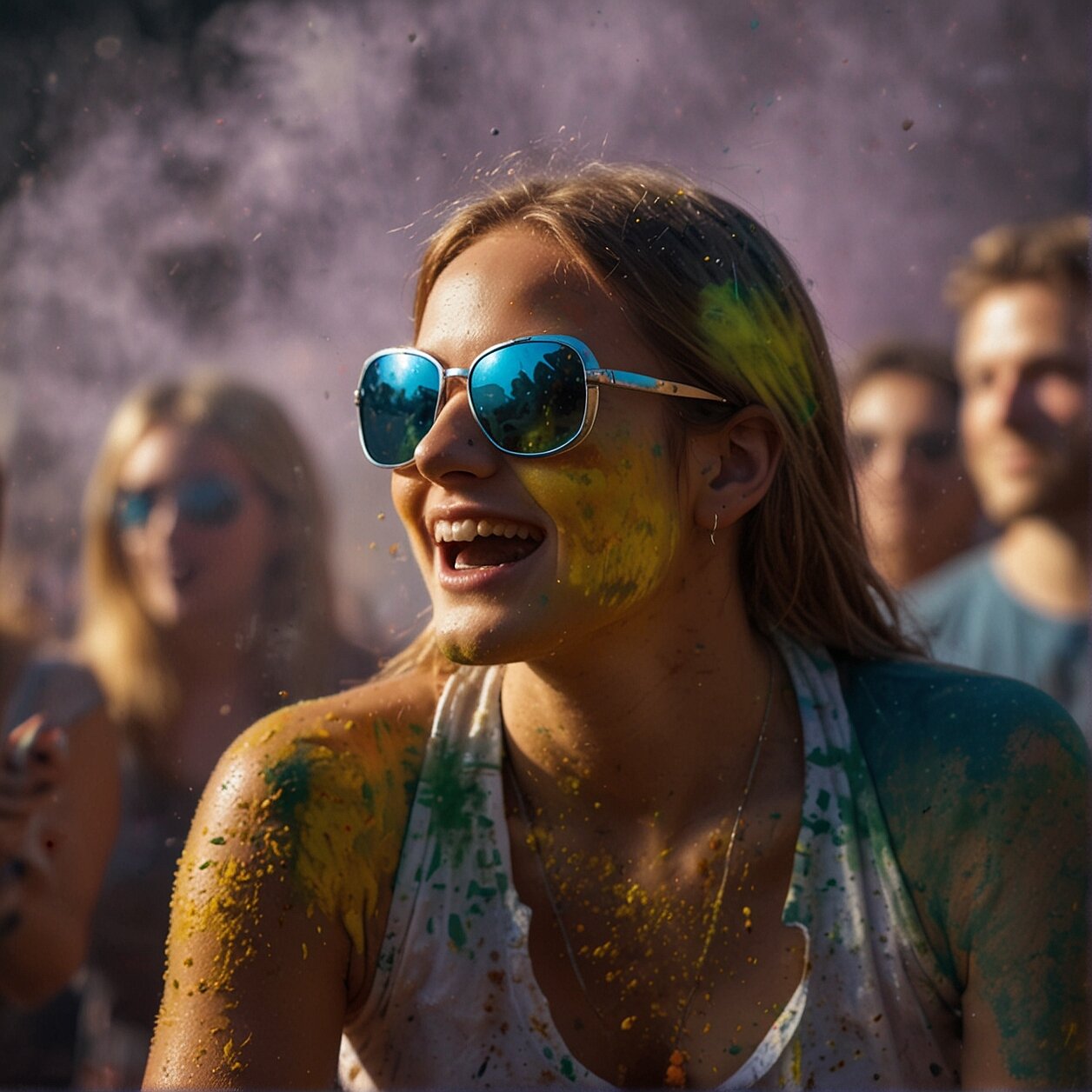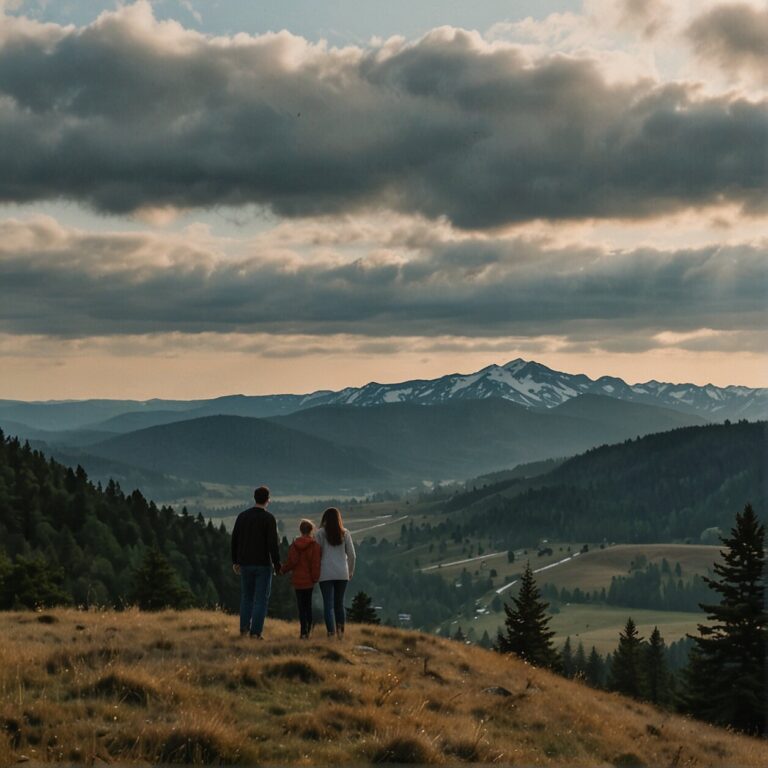Navigating the Colorful Chaos of India’s Holi Festival
The Holi festival is often considered the most energetic, chaotic, and unequivocally jubilant celebration in India, painting cities with rainbow hues and fostering a unique sense of community and camaraderie. A riot of color where social norms are temporarily forgotten in exchange for spirited enjoyment, Holi embodies the magnificence of Indian culture with its vibrant traditions and rituals. But what can you expect when celebrating Holi in India? How can you immerse yourself in this spirited symphony of color? Let’s delve into the intricate fabric of Holi’s many shades and provide some practical tips for navigating this lively event.
Understanding Holi isn’t just about knowing the customs and rituals; it’s about feeling it beat within you. With each handful of ‘gulal’ (colored powder) soaring through the air and every exuberant water fight that drenches you in hues of pink, blue, and yellow, you’re connecting with a millennia-old tradition that breaks down social barriers and brings people together in an exuberant explosion of color and joy.
Experiencing Holi as a foreigner, it’s important to remember that there’s more than just physical participation. Embracing the celebration means understanding its history, respecting its traditions, and appreciating its cultural significance. Truly engaging in Holi demands an openness to immerse yourself in a culture very different from your own, leaning into the chaos, and surrendering to the sheer joyfulness of the festival.
“Holi is not just a festival; it’s a feeling, an emotion. It’s the spirit of unity and joy, exploding in a burst of colors.”
So, if you’re planning on attending Holi, here are a few key things to remember:
- Respect the cultural significance of the festival. Don’t just see it as a photo-op; engage in the traditions and understand the history behind them.
- Embrace the chaos. The streets will be packed, the air filled with color, and water fights breaking out left and right. This is part of the Holi experience.
- Dress appropriately. Opt for clothing you don’t mind getting smeared with color, and consider wearing sunglasses to protect your eyes from the colored powders.
- Be cautious. While Holi is generally safe, like any large event, it can sometimes attract pickpockets or opportunistic thieves. Keep your belongings secure and stay within the crowds.
Remember, Holi is about celebrating the arrival of spring, communal unity, and the triumph of good over evil. It’s a festival that adds a dash of color to life, reminding us of the vibrancy and joy inherent in our existence.
The Splash of Color: Understanding the Holi Festival
Holi, even though deeply rooted in Hindu legends and mythology, transcends religious boundaries to emerge as a global celebration of life, love, and color. Typically, it marks the jubilant transition of winter into spring and brings the promise of an abundant harvest.
What distinguishes Holi from the array of other Indian festivals is the riotous display of colors. People, both young and old, are seen jovially smearing each other’s faces with colored powders, gleefully tossing buckets of colored water, and shooting others with water guns filled with vibrant hues. The festival, having its roots in an ancient tradition, is an embodiment of the country’s colorful history and cultural intricacy.
Each color thrown during Holi holds its distinct meaning, representing various aspects of human life and emotion. For instance, red signifies love and fertility while the unmissable yellow comes as a tribute to the color of turmeric, a spice integral to the Indian subcontinent. The blue is a nod to Lord Krishna, who is often depicted with blue skin, while green symbolizes life and happiness.
The revelries of Holi are not confined to mere tomfoolery; there is much more to the carnival of colors. The festival also hosts a legion of traditional music and dance performances, making Holi a sensory overload of sight, sound, color, and rhythm that is truly unparalleled.

Painting the Town Red, and Blue, and Yellow: The Psychedelic Hues of Holi
Imagine the sight as thousands of joyous individuals, awash in a tidal wave of vibrantly-hued powders, illuminate the streets with a kaleidoscope of colors. This is the heart and soul of Holi, a time when every corner of India transforms into an enormous canvas showcasing a breathtaking array of psychedelic hues. It’s a spectacle that exemplifies the raw, unadulterated joy of the Holi festival.
The celebration of Holi is an ebullient display of life, love, and laughter. As participants toss vibrant “gulal” (colored powders) and “rang” (colored waters) at each other, they not only cover each other in a luminous palette of the rainbow but also symbolically paint their hearts with love and camaraderie. This vibrant spectacle is a nod to the playful colouring of Radha and Krishna’s faces, an iconic event deeply rooted in Hindu tradition and folklore.
The colors of Holi deeply reflect the festival’s spirit and the very essence of India itself – Unity in Diversity. Each shade carries a specific cultural significance and represents different sentiments and emotions – be it the beautiful blues echoing Krishna, the fearless reds expressing love and vitality, or the warm yellows symbolizing knowledge and learning. Participants drenched in these radiant colors embody the Holi essence in all its spectacular vibrancy.
The radiant spectacle promises a memorable and photogenic experience that serves as the ultimate reminder of Holi’s powerful message – that in the end, love and joy wash away all differences, uniting us in a vibrant celebration of life. Trust us: once you witness and immerse yourself in this dazzling display of colors, your perception of India and its cultural richness will be changed forever!
Embracing the Holi Spirit: How to Celebrate the Indian Festival of Colors
Picture a scene where the streets are awash in a kaleidoscope of color, and joyous laughter fills the air. That’s Holi for you, a spectacular and infectious celebration that transcends all boundaries. A chance for you to cast off any inhibitions and immerse yourself in the spirit of togetherness. So, how do you get in on the color-spattered action?
For starters, be willing to get dirty and doused in colored powders, or gulal, made from natural sources like flowers and spices. It’s all part of the fun, adorning each other in brilliant hues. Bystanders, friends, and family will smear these on your clothes and skin, symbolizing the breaking down of social norms and celebrating unity.
Engage in dancing, singing, and drumming with others, even if you’re a beginner. Holi is all about collective joy, and the rhythmic beats of the dhol (drum) serve as the heart of this celebration, motivating even the most reluctant to break into a jig.
If you’re in North India, expect to witness the iconic Holi tradition of Lathmar, where women chase away men with sticks – a playful reenactment of a Hindu mythological tale. In other regions, you might have the chance to take part in the eclectic festivities of Holika Dahan, a bonfire that represents triumph of good over evil.
Because Holi is also known as the festival of love and spring, it’s common to see folks exchanging warm greetings, sweets, and hugs. Don’t hesitate to respond in kind, as this exchange strengthens bonds of kinship and refreshes familial ties.
Feeding your taste buds with Holi native delicacies should also be on your agenda. Try gujiya, a sweet, flaky pastry filled with dried fruits and coconut, or thandai, a special Holi beverage spiced with fennel seeds, almonds, rose petals, and cardamom.
In conclusion, celebrating Holi is a unique and vibrant experience, filled with colors, love, and camaraderie. Visually stunning, emotionally enriching, and soul-stirringly joyous, it’s a cultural immersion not to be missed.
Joining the Holi Madness: Practical Tips for Celebrating Holi in India
Speaking of Holi, perhaps the image that comes to mind is a phantasmagoria of colors, laughter and high-spirited energy. However, in order to truly appreciate the festival, you must be prepared for the madness that unfolds. Given that, here are some practical tips to help you navigate your Holi experience in India.
First things first, remember to dress appropriately. The color splashing is all in good fun, but things can certainly get messy. Stick to clothes that you don’t mind getting stained, and ensure they’re made of comfortable, light materials to accommodate for India’s often sweltering March heat.
While embarking on this festive adventure, don’t be surprised by the sudden explosions of color heading towards you. The tradition of throwing colored water and powder is the highlight of Holi. Revel in it! If you’re keen on capturing the spirit of the festival in images, waterproof gear for your camera or phone would be a wise investment.
Protection is paramount, not just for your gadgets, but for you as well. As much as you might be swayed to dive into the festivities, don’t forget to slather on a good amount of sunscreen and oil your skin and hair. Not only will the sunscreen protect you from the intense Indian sun, but the oil will also act as a barrier between your skin and hair and the colors, making the post-festival cleanup far easier.
In the jubilant chaos of the celebrations, remember to watch what you eat and drink. Try to ensure that your food and drink are safe — sticking to bottled water is a good advice. Some might offer you the traditional ‘bhang’, a local drink infused with cannabis. While it’s a part of the customary fun, knowing your own tolerance level is important.
While Holi is all about embracing the festivities and mingling with locals, it’s equally important to be cautious about your surroundings. Be respectful of the cultural norms. Remember, the event is rooted in religious traditions and it’s crucial to behave in a way that respects these practices.
Regardless of how you choose to join in the revelry or where you find yourself celebrating, always remember that this spirited festival is about rejoicing in color, camaraderie and unity. So go ahead and lose yourself in the Holi madness, you’re undoubtedly in for an unforgettable experience.

Enjoying Holi Like a Local: A Comprehensive Guide
Immersing yourself in the colorful festivities of Holi can be an exhilarating experience. To get the most out of your participation, it’s important to blend in with the locals and understand the customs associated with the celebration. Here’s your comprehensive guide to relishing Holi in its purest form.
You might want to kick off the celebration with Holika Dahan, a ritual held on the eve of Holi. A fire is lit to symbolize the victory of good over evil, in remembrance of the mythical tale of Prahlad and Holika. As you watch the fire, you’ll observe locals singing and dancing around the pyre, rejoicing in the spirit of festival.
As Holi is a celebration of unity, don’t hesitate to join in the fun alongside the locals. You will notice people of all ages laughing, singing, dancing, and above all, throwing vibrant-colored powders at each other. It’s a good way to meet new people and deepen your understanding of this joyous festival.
Remember to indulge in the gastronomic delights unique to Holi as well. The festival is incomplete without delectable sweets and savory delicacies. Local favorites include gujiya, a sweet dumpling stuffed with dry fruits, samosa, a savory pastry filled with spiced potatoes, and bhang, a traditional Holi beverage made from cannabis. Sharing food is a significant part of the festival; it fosters a sense of community and camaraderie.
Last but not least, respect local customs. While Holi is a boisterous celebration, it is still deeply rooted in tradition and reverence. Please remember to respect personal boundaries and don’t throw color at unwilling participants. Removing colors can be a tedious process; hence many Indians prefer organic and allergy-free colors. It would be wise for you to follow suit.
All in all, there’s no better way to experience Holi than to live it like the locals do. Engage in the celebrations with an open mind and you will come away with cherished memories of this unique festival.
FAQ’S
Before we immerse ourselves in the radiant world of Holi, it’s essential to bring to light some of the most frequently asked questions about this lush spectacle. In this section, we’ll bring clarity to your lingering queries, whether they be about the deeper significance of the Holi colors, participation as a foreigner, vital precautions, recommended locales, or the etiquette to be followed during the celebration. So, let’s dive into a spectrum of questions to enhance your understanding of this vibrant festival.
Why is Holi festival celebrated with colors?
When it comes to Holi, colors are more than just vibrant hues to paint the town with. They’re deeply intertwined with the festival’s cultural and historical symbolism. The playful throwing of colored powders and water hails back to mythical tales of Lord Krishna, who was known to play pranks on the village girls by drenching them in water and colors. As a nod to this, Holi celebrants cheerfully douse each other in a similar fashion, rejuvenating the story in a modern context.
Interestingly, each color carries its unique connotations during Holi. Red, for instance, symbolizes love and fertility, while green is associated with life and vibrancy. Yellow stands for knowledge and learning, and blue, the color of Lord Krishna, signifies the divine. Thus, being doused in these colors isn’t just fun, but is also a way of sharing and receiving blessings associated with each hue.
And it’s not just India where you’ll see this explosion of color. The festival has gained popularity across the globe, and countries such as Suriname celebrate a similar event known as the Phagwa festival, emulating the very heart of Holi – colors, love, and spring. Through these colours, people around the globe are connected, entering a world where everyone is equal under a rainbow of pigments. Holi truly is a festival that breaks down barriers and brings people together in the most vibrant way possible.
How can I participate in the Holi festival if I am a foreigner?
The thought of participating in the Holi festival might look daunting at first, but rest assured it’s a more simple process than it seems. Everyone is welcome to partake in this colorful extravaganza, regardless of nationality or cultural background. Here are some pointers to help you participate in the Holi festival as a foreigner.
Firstly, reach out to your local Indian community or embassy. They often host Holi events suitable for newcomers, providing a safe and comfortable environment to partake in the festivities. This also provides an opportunity to learn more about the cultural significance and proper etiquette of the festival. In many regions, the Indian diaspora, be it in North America, Europe, Latin America, Fiji, or parts of Asia, celebrate Holi with grandeur, so you’re likely to find such an event near you.
If you’re fortunate enough to visit India during Holi, choosing the right location can greatly enhance your experience. Holi celebrations take different forms in different parts of the country, each with its own unique traditions. For example, Holi in the Braj region, especially Mathura and Vrindavan, are famous globally for their exuberant celebrations. However, attending local celebrations in whichever part of India you are, can be equally exciting.
Remember to dress appropriately for the occasion. The rule of thumb is to wear light, old clothes that you’re willing to part with – because they’re likely to get covered in color and water. It’s also advisable to apply a layer of oil or moisturizer to your hair and skin in advance. This makes it easier to wash off the colors later. Some foreigners prefer to wear traditional Indian clothes, such as the ‘kurta-pajama’ for men, and ‘salwar-kameez’ for women, to blend in and imbibe the local spirit.
Once you’re part of the festival, let loose and enjoy! Remember, the essence of Holi lies in the free-spirited interaction of people, transcending boundaries of cultures and nationalities. So whether you’re tossing colored powders, grooving to the music, relishing traditional foods like gujiya and dahi bhalla, or simply marveling at the celebration unfolding in front of your eyes – enjoy every moment of it.
Lastly, bear in mind, Holi is more than just a festivity of colors. It’s a cultural celebration of unity, love, and positive energy that will surely leave you with fond lifelong memories.
What precautions should I take while attending the Holi festival?
As joyous and thrilling as Holi celebrations can be, it’s important for you, as an eager participant, to take some precautions to make the most of the festival while ensuring your safety and well-being. Here are some practical tips to bear in mind.
1. Protect Your Skin and Eyes: The Holi colors, while vibrant and fun to play with, can sometimes be harsh on your skin and eyes. To mitigate this, consider applying a good quality sunscreen or oil to your skin before stepping into the festivities. This forms a protective layer on your skin and prevents the direct contact of colors. Additionally, wearing sunglasses can help shield your eyes from the direct impact of colored powder.
2. Choose Organic Colors: If possible, opt for organic Holi colors. These are often less harmful to the skin and are easier to wash off. Many vendors in India sell eco-friendly Holi colors that are made from natural ingredients like flowers and herbs.
3. Dress Appropriately: When attending Holi, think about wearing long-sleeved tops and full-length trousers to minimize skin exposure. Choosing old clothes that you don’t mind ruining with color is also a good idea. The traditional attire of a simple white kurta can also be an option for the authentic Holi experience.
4. Stay Aware: While Holi is generally a safe festival, like with any large public event, it’s crucial to keep an eye on your belongings and stay aware of your surroundings. If you’re traveling with a group, arrange a common meeting point in case you get separated.
5. Hydrate and Eat Light: Amidst all the revelry, don’t forget to hydrate yourself regularly. With all the dancing and running around, it’s easy to get dehydrated. Eating light and healthy before the event can also keep you energized throughout the day. Try local delicacies like gujiya, lassi, and dahi bhalla, but be cautious about where you buy these from.
Remember, Holi is all about having fun in a respectful and considerate way. So, follow these guidelines and you’ll surely have a memorable Holi experience amidst the explosion of colors and camaraderie!
What are some recommended locations to celebrate Holi in India?
While there’s a unique charm in experiencing Holi wherever you might be in India, some places provide a truly spectacular experience. Let me give you my top picks for celebrating Holi in the country.
1. Mathura and Vrindavan: These twin towns in Uttar Pradesh host one of the grandest Holi celebrations in all of India. Holi in Mathura and Vrindavan is an enlightening spectacle featuring love legends of Radha and Krishna. The festival is stretched to a week here, with various unique traditions marking each day. If you desire an immersive cultural encounter, there’s arguably no better place.
2. Barsana: Also in Uttar Pradesh, Barsana is famous for its diverse take on Holi. Barsana is known for “Lathmar Holi” where playful, mock fights ensue between women of Barsana and men from neighboring Nandgaon. Again, this is tied back to the playful traditions of Radha and Krishna. The obscure tradition coupled with an array of vibrant colors makes with an unforgettable Holi experience.
3. Shantiniketan, West Bengal: This quiet town becomes a cultural hotspot during Holi. Initially started by the famed poet Rabindranath Tagore, the ‘Basant Utsav’ or Spring Festival incorporates songs, dance, and, of course, colors to welcome the onset of spring.
4. Jaipur and Udaipur, Rajasthan: The ‘Land of Kings’ adds a regal touch to Holi. Elephant parades, beauty contests, tug-of-war, and other traditional games blend with the explosion of colors, making for an ethereal Holi experience.
Are there any etiquette rules to follow during Holi celebrations?
Yes, indeed there are etiquette rules to follow during Holi celebrations, ensuring everyone can enjoy the vibrant festivities safely and respectfully. Mindful participation is key when involving yourself in such a cross-cultural experience.
Firstly, consent plays a major role – it’s good practice to always seek permission before smearing colors on someone’s face, especially if they are a stranger. This is not just a cultural etiquette but also a principle of respect and goodwill.
Furthermore, be mindful of the potent dichotomy of Holi’s colors – although each possesses a different meaning, one must treat all the colors with equal reverence and respect. It’s inappropriate, for instance, to throw color on monuments, temples, or anyone who does not wish to participate.
It’s also important to dress modestly, as Holi is a family festival celebrated across all stratas of society. Traditional clothes, usually white to let the colors show, are the norm. However, ensure your clothing is comfortable and can handle getting soaked as water guns and water-filled balloons are a common sight.
To reduce the environmental impact, opt for organic colors rather than harmful synthetic colors. This not only protects your skin but also contributes to the preservation of the environment. And remember, it’s not necessary to drench someone in colors- a light sprinkle or smearing is enough to express your joy and partake in the fun.
Lastly, remember to cherish the spirit of the Holi festival, which underlines social harmony and unity. It’s a day to let go of past misunderstandings and celebrate togetherness, so embracing this philosophy will ensure your experience is truly authentic.
Now that you’re equipped with these etiquette tips, you’re ready to dive headfirst into the colorful extravaganza that is Holi!







